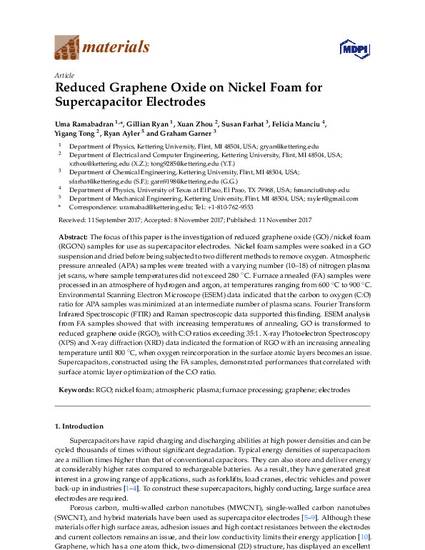
The focus of this paper is the investigation of reduced graphene oxide (GO)/nickel foam (RGON) samples for use as supercapacitor electrodes. Nickel foam samples were soaked in a GO suspension and dried before being subjected to two different methods to remove oxygen. Atmospheric pressure annealed (APA) samples were treated with a varying number (10–18) of nitrogen plasma jet scans, where sample temperatures did not exceed 280 °C. Furnace annealed (FA) samples were processed in an atmosphere of hydrogen and argon, at temperatures ranging from 600 °C to 900 °C. Environmental Scanning Electron Microscope (ESEM) data indicated that the carbon to oxygen (C:O) ratio for APA samples was minimized at an intermediate number of plasma scans. Fourier Transform Infrared Spectroscopic (FTIR) and Raman spectroscopic data supported this finding. ESEM analysis from FA samples showed that with increasing temperatures of annealing, GO is transformed to reduced graphene oxide (RGO), with C:O ratios exceeding 35:1. X-ray Photoelectron Spectroscopy (XPS) and X-ray diffraction (XRD) data indicated the formation of RGO with an increasing annealing temperature until 800 °C, when oxygen reincorporation in the surface atomic layers becomes an issue. Supercapacitors, constructed using the FA samples, demonstrated performances that correlated with surface atomic layer optimization of the C:O ratio.
© 2017 by the authors. Licensee MDPI, Basel, Switzerland. This article is an open access article distributed under the terms and conditions of the Creative Commons Attribution (CC BY) license (http://creativecommons.org/licenses/by/4.0/).
Available at: http://works.bepress.com/uma-ramabadran/1/

Published by MDPI AG, Basel, Switzerland; http://www.mdpi.com/journal/materials